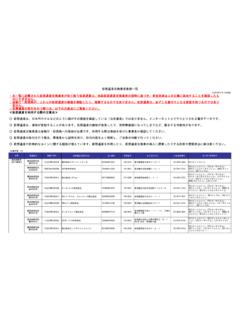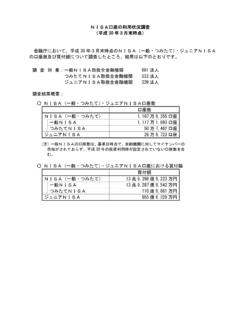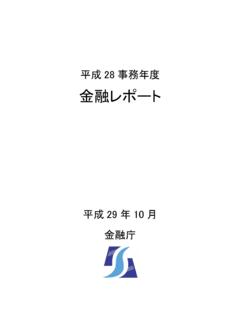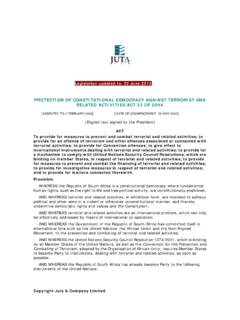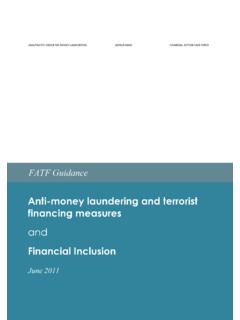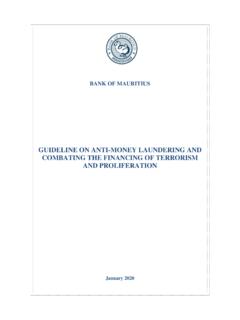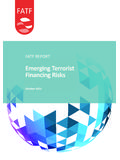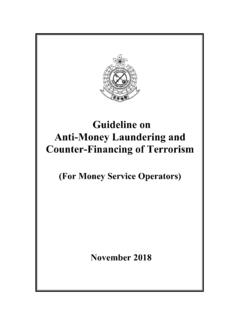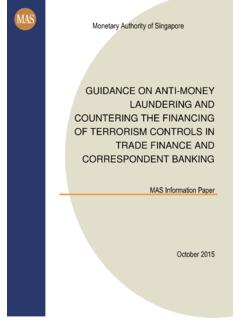Transcription of [Provisional Translation]
1 [Provisional Translation] The original texts of the Guidelines are prepared in Japanese, and this translation is only provisional. The translation is to be used solely as reference material to aid the understanding of the Guidelines and is subject to any future changes. Guidelines for Anti-Money Laundering and combating the financing of terrorism April 10, 2019 Financial Services Agency IGeneral Concepts .. 1I-1 Risk-based approach .. 1I-2 Financial institutions AML/CFT measures .. 3(1)ML/FT risk management .. 3(2)Involvement and understanding of 4I-3 Roles of industry associations and central institutions .. 4I-4 Supervisory actions .. 5 IIRisk-Based Approach .. 6II-1 Risk-based approach .. 6II-2 Identification, assessment, and mitigation of risk .. 6(1)Risk identification .. 7(2)Risk assessment .. 8(3)Risk mitigation .. 9(i)Risk mitigation measures .. 9(ii)Customer due diligence (CDD) .. 10(iii)Transaction monitoring and screening .. 14(iv)Record keeping.
2 15(v)Suspicious transaction reporting (STR) .. 15(vi)IT systems .. 16(vii)Data governance .. 17(4)Foreign remittance .. 18(5)FinTech .. 20 IIIE valuation and Review of the ML/FT Risk Management and Its Effectiveness .. 20 III-1 Formulation, implementation, evaluation, and review of AML/CFT policies, procedures and programs (PDCA) .. 21 III-2 Involvement and understanding of management .. 22 III-3 Management and control: three lines of defense .. 23 III-4 Group-wide risk management .. 26 III-5 Human resource development .. 28 IVMonitoring and Public Private Partnership .. 29IV-1 Monitoring by the Financial Services 29IV-2 Public private partnership and cooperation with relevant authorities .. 301 I General Concepts I-1 Risk-based approach The basic requirements on anti-money laundering and combating the financing of terrorism ( AML/CFT ) in Japan, such as identification and verification at the time of transactions, are prescribed in the Act on Prevention of Transfer of Criminal Proceeds ( Criminal Proceeds Act ), the Foreign Exchange and Foreign Trade Act ( Foreign Exchange Act ), and other relevant laws and regulations.
3 Financial institutions licensed or registered to conduct operations under the Banking Act, the Insurance Business Act, the Financial Instruments and Exchange Act, and other laws that introduce legislation for each type of business in the financial industry are legally regarded as a specified business operator under the Criminal Proceeds Act, as well as Banks, etc. or Financial institutions, etc. under the Foreign Exchange Act, and therefore are subject to relevant requirements prescribed in such laws and regulations. Since a financial system is a network of various flows of funds in the diversified forms of remittances, settlements, and money transfers conducted by the financial institutions, in order to ensure the soundness of the entire financial system, it is vital that individual financial institutions participating in the financial system shall build and maintain solid risk management commensurate with their operations and roles in the financial system.
4 AML/CFT measures that a financial institution should take are substantially influenced by ever-changing international affairs, as well as the constantly evolving actions by other financial institutions against such external circumstances. Financial institutions need to swiftly respond to the changes in such circumstances and their corresponding risk profiles, and effectively maintain their money laundering and the financing of terrorism ( ML/FT ) risk management. Implementing such swift and effective countermeasures requires financial institutions to appropriately identify and assess the ML/FT risks they face in a timely manner including risks relating to their customers operations , and to undertake mitigation measures commensurate with those risks, namely a risk-based approach. The risk-based approach for ML/FT risk management is established as a central principle of the Financial Action Task Force ( FATF ) Recommendations, and has equally been an established practice in major developed countries.
5 With the need for swift and effective measures, the risk-based approach is a minimum standard that financial institutions participating in Japan s financial system should implement. In particular, under the increasing threat of terrorism faced by the international community, 2 close attention is necessary for the fact that calls for stricter AML/CFT measures have rapidly increased, as seen in the past cases in which inadequate AML/CFT measures led financial institutions to face large fines from foreign authorities or the termination of correspondent banking arrangements from their foreign counterparties. Taking proper actions by Japan s financial system in response to such calls is necessary. In particular, those financial institutions engaging in foreign remittances need to sufficiently respond to supervision by foreign authorities and other international AML/CFT developments.
6 As the threat of terrorism has spread across borders, financial institutions shall establish effective risk management for terrorist financing with the awareness that their products and services can be abused as tools for terrorist financing . For example, in the case where a financial institution conducts a transaction with a non-profit organization, it is important for financial institutions to be aware that they are at risk of being exploited for terrorist financing depending on the nature and areas of their activities, while presuming that not all non-profit organizations are inherently higher-risk customers, and to take necessary risk mitigation measures taking into account the National Risk Assessment (Japanese NRA as provided for in the Criminal Proceeds Act) and the analyses by the FATF. Financial institutions shall establish appropriate risk management, including measures addressing the financing of proliferation of weapons of mass destruction, taking into account relevant foreign and domestic laws and regulations such as the Foreign Exchange Act and the Act on Special Measures Concerning International Terrorist Assets Freezing.
7 To this end, financial institutions need to continuously improve AML/CFT measures through a firm-wide governance structure involving different divisions and geographic areas and facilitating the proactive involvement of management, thereby ensuring that AML/CFT measures effectively function in business divisions that principally serve customers. Financial institutions should develop in their business strategies forward-looking actions for strengthening their AML/CFT measures for preventing the future misuse of their functions. They should also fulfill their accountability to a wide range of stakeholders including customers and authorities with regard to their policies, procedures, programs as well as their implementation status by disclosing relevant data. The Financial Services Agency ( FSA ), with necessary supervisory measures, shall monitor the AML/CFT measures of each financial institution, share the outcome with financial institutions, and urge them to enhance risk management.
8 The Guidelines clarify the required actions and expected actions to be implemented by each financial institution and how the FSA shall conduct monitoring going forward. 3 Furthermore, in an effort to encourage financial institutions to make forward-looking enhancements, the Guidelines provide better examples found through the past monitoring or in foreign financial institutions as cases of advanced practices, as a reference for financial institutions to pursue best practices. The Guidelines also explain the roles of industry associations and central institutions and coordination with the authorities, with a view in particular to helping financial institutions with small sizes or limited scope of transactions to develop effective risk management programs. I-2 Financial institutions AML/CFT measures (1)ML/FT risk management Financial institutions are required to identify and assess their ML/FT risks based on an overall group-wide understanding of their products and services, transaction types, countries and geographic areas, and customer attributes, and to implement mitigation measures commensurate with such risks, taking into account their business environment and strategies as well as their risk tolerances.
9 In order to swiftly undertake measures commensurate with those risks that reflect ever-changing international circumstances and the evolving responses by other financial institutions, it is vital not only to address individual cases or problems, but rather, with the involvement and understanding of management, to undertake holistic forward-looking evaluation including the necessity for reforming their management and risk management programs, and develop a group-wide effective ML/FT risk management. To address this perspective, the FSA plans to regularly review the Guidelines. Equally, financial institutions are required to establish and maintain their risk management reflecting the substantive contents of related laws and regulations and the Guidelines, not focusing exclusively on compliance with those regulations and the Guidelines and checking technical compliance with them. While there are differences between the risks of money laundering and the financing of terrorism such as the purpose, size, and value of those transactions as well as the countries or geographic areas that need caution upon executing those transactions the basic frameworks required to maintain the soundness of the financial system do not differ fundamentally among those transactions.
10 The Guidelines therefore explain AML and CFT simultaneously. 4 (2) Involvement and understanding of management When developing the aforementioned ML/FT risk management, the proactive involvement of management, based on the understanding that ML/FT risk can be significant for the entire firm, is indispensable. In fact, AML/CFT measures shall not solely be left to the related divisions. The proactive engagement and leadership of management would be necessary, for example, in conducting a forward-looking gap analysis, taking cross-organizational measures involving multiple divisions, and strategically hiring and training their personnel and allocating resources according to their expertise and experience. In order to disseminate AML/CFT initiatives to all executives and employees, it would also be important to demonstrate management s proactive commitment toward AML/CFT and convey their messages, such as by taking into account AML/CFT in the performance evaluation of employees.
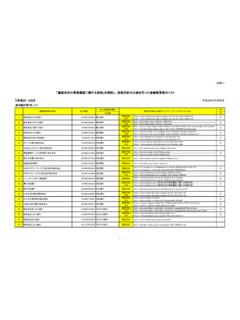
![[東京都:信用金庫] - fsa.go.jp](/cache/preview/c/b/c/f/9/b/2/3/thumb-cbcf9b238b9447f309f8c0cf15fe13b5.jpg)
